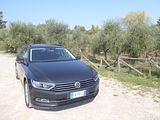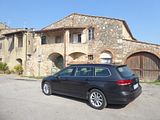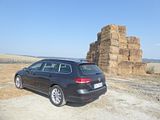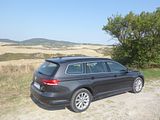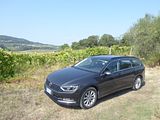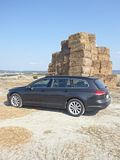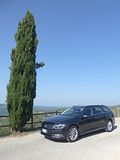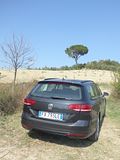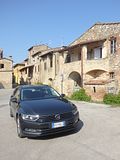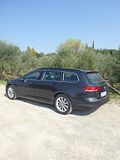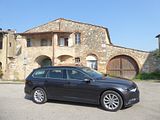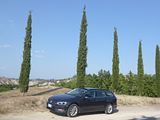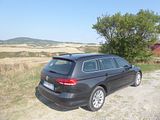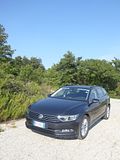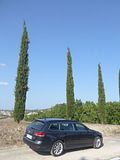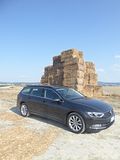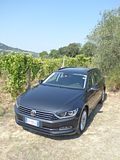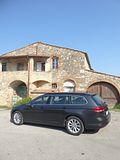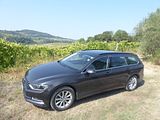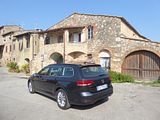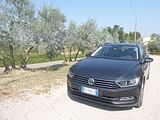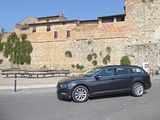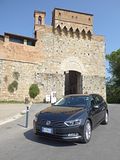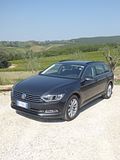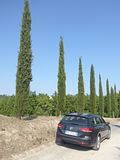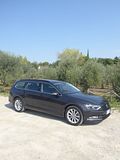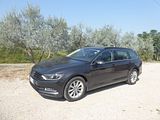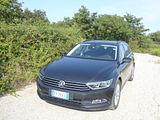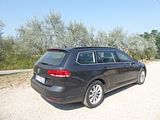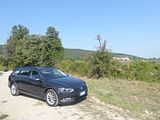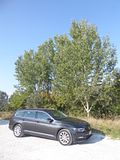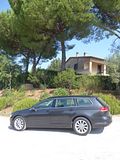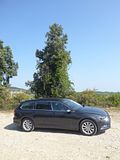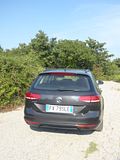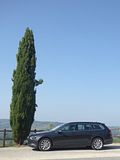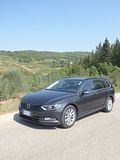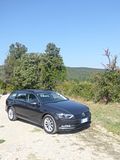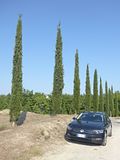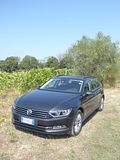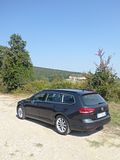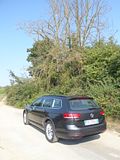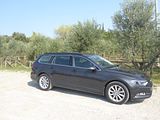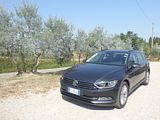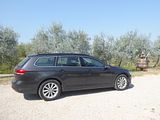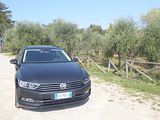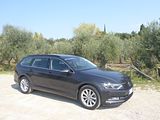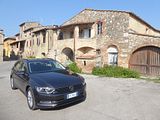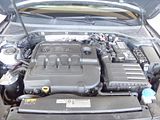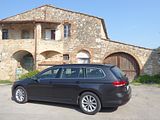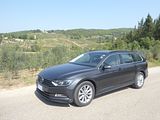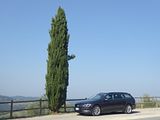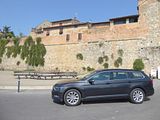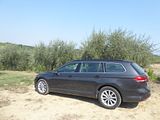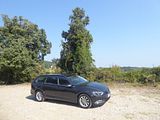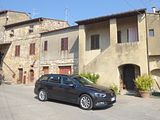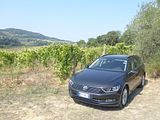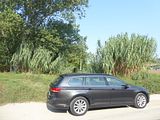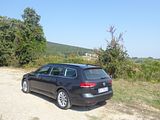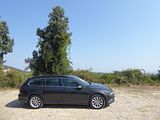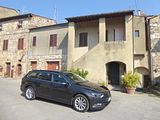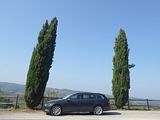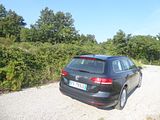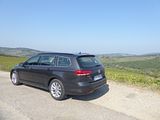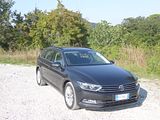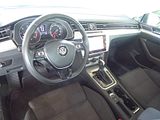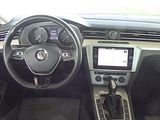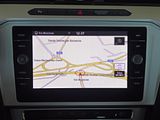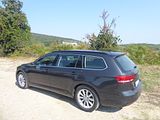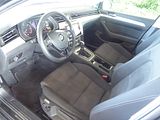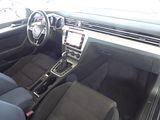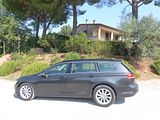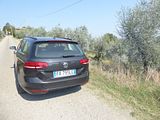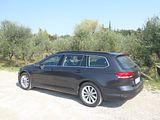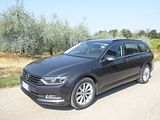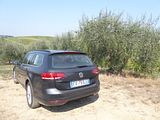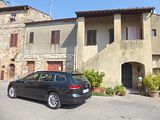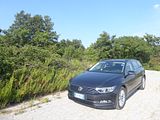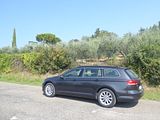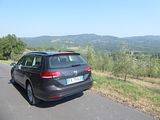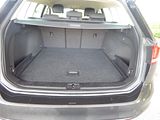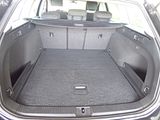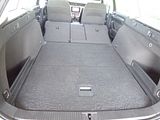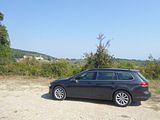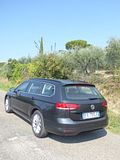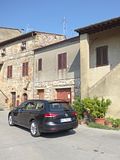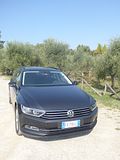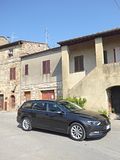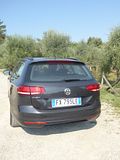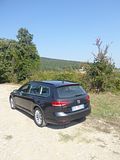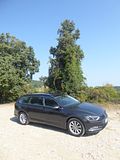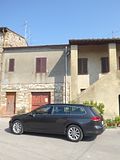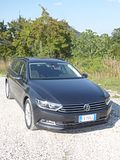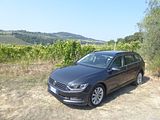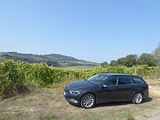Recent years have seen a dramatic decline in sales of what are sometimes called D-Segment cars, the large family saloon exemplified in the UK by the Ford Mondeo and its predecessors in title. This is a market segment that, perhaps at a greater rate than other, has moved over to the Crossover. Accordingly the number of different models on offer in this class has been steadily reducing and all the indications are that not all of those that do remain will receive a direct replacement. In the UK, the class has long been dominated by the Ford Mondeo and Vauxhall Insignia, and in France, it is the domestic products from Renault, Peugeot and Citroen that have always found favour, but if you add up the sales of all the various available class options, then one dominates by a massive margin, the VW Passat. First seen in 1973, the Passat was the first of the new front wheel drive family of cars that created the market power-house that is the Volkswagen of today. The Passat has matured through a number of different generations – 8 perhaps, though it does depend on whether you count a couple of the extensive facelifts as new cars or not. The current model, offered with a choice of saloon or estate bodies, as have been all Passats since the hatch models were consigned to the history books back in 1988, made its debut in 2015. Looking little different from the 2010 facelift of the 2005 car (following this?), it was in fact as much of an all-new car as you get these days. Passat has never really been about excitement, and on the few occasions when a potent model – the VR6 version of the third generation car or the more recent and very short-lived R36 version of the previous generation model – were on sale, they found few customers. Passat is instead all about providing no nonsense dependable family transport with class-leading levels of quality. It is even quite competitive on prices these days, as VW found in the early days that customers were put off when the car was priced too highly, as was generally the case outside its native Germany. I drove quite a few examples of the last generation Passat with a variety of the available engines and gearboxes and in both saloon and estate format, but since the launch of the latest car, the model has eluded me completely. However, when arriving at Pisa airport in September 2020 for a much-needed holiday in a world that had opened up a little to allow travel after months of enforced lock downs, I found that Hertz Italia had allocated a Passat Estate to me, despite the fact that I had booked something else (notionally more costly as a rental car). With fleets having off-loaded what they could once lockdown struck, you really have to accept that they have what they have at present, and from a look around the facility at Pisa airport, it was quite clear that this was the largest and costliest car they had among a sea of Fiat Panda and other small cars. So I signed the paperwork and headed off for a week with the latest Passat to see what I thought.
The car I received was in fact registered in late 2018, and had clearly been well used for the first year or so of rental duty but I am guessing had not seen much action throughout 2020 which is why it was still on fleet. Not surprisingly, it was a diesel powered car, which meant that under the bonnet was the familiar 1.6 TDi unit that was pretty ubiquitous in a vast array of VW Group cars until the combined repercussions of Dieselgate and the clamour to move to zero-carbon started the steady and rapid decline in the popularity of this fuel type. Developing 120 PS, the 1.6 TDi is the smaller and least powerful of the four diesel engine choices that feature in the B8 generation Passat, the others all being based around a 2.0 TDi unit, with 150 PS, 190 PS or in top spec BiTDi form 220 PS. Petrol engines came some while after the initial launch but then for a while there were a bewildering array of these on offer but demand was low and many of these disappeared from the range fairly quickly. Italian customers only get one pure petrol choice these days, the 125 PS 1.5 litre TSi EVO engine that replaced the earlier 1.4 TSi unit of the same power and the 212 PS plug-in hybrid GTE model was pulled from sale in Italy during 2018 though it remains available in other markets where more powerful petrols are available all the way up to a 272 PS unit. These days, most Passats will come with a 7 speed automatic gearbox but a 6 speed manual is available in some of the less potent models. Those who wanted to go further with all-weather capability could select an AllTrack version of the Estate with raised suspension and lower bodywork cladding, and for ultimate economy a BlueMotion version of the 1.6 litre diesel had a number of tweaks to make it go that bit further on a gallon of fuel, though again this was relatively short-lived.
VW have worked hard over the years to refine their diesel engines and have largely succeeded. The unit in this car is quite smooth, exhibits none of the once characteristic rattly sound but it is not always as refined as you might hope for. With quite a large and heavy car to propel, acceleration from the engine is best described as adequate rather than brisk. Certainly on some of those Tuscan hills, the car had to be worked quite hard to maintain reasonable speed, which does increase the noise levels somewhat though once up to a cruise on the autostrada, it is generally quite civilised. The test car had the 7 speed DSG automatic transmission and this proved to be a bit of a let-down. The transmission had a habit of holding onto gears, be that one which was too low or too high. I covered 1035 km before returning the car back to Pisa airport, and the fuel gauge still showed 3/16ths of a tank remaining. I put 54 litres in and it showed full again. A stab at the calculator renders that into a decent 54.34 mpg, a good result.
Unlike the Passat’s rivals from Ford or Mazda, the emphasis appears to have been on making the VW easy to drive as opposed to necessarily being that much fun. The steering is the biggest manifestation of this. It is light and has not got a great deal of feel to it, so whilst the car is easy to manoeuvre, you don’t have a lot in the way of clues as to what the steered wheels are going to do. That said, the Passat handles OK, feeling utterly predictable, with fairly low levels of body roll and lots of grip and it felt safe and secure on the twisty roads in Tuscany where I covered much of the test mileage. The test car came on 215/55 R17 tyres which are on the higher profile side for cars of this size and type, which no doubt helps to ensure that the ride quality is generally good, with the Passat coping well with the varied surfaces that you find on Italian roads. The brakes seemed good, though I had no cause to give them a real stern test. There is an electronic handbrake in the centre console, though with this being an automatic, I did not use it. Visibility is generally good. There are all-round sensors which help in tight situations, though these do not project anything onto the infotainment screen. Somewhat unusually, I found that there was a lot of buffeting with the windows down.
As you might expect from a VW, there is a high quality interior with lots of soft touch plastics that are pleasant to look at and to touch. The main mouldings are black, but some visual relief comes from the extensive use of a mottled effect silver inlay and there is a stylish motif stretching from one side of the dashboard to the other through the vents, with a small analogue clock in the centrepiece. There is a good quality leather wrap on the steering wheel which makes it nice to hold and the various switches and buttons all operate with a precision and a feeling that they will last well. Much of the componentry will be instantly recognised by anyone familiar with any contemporary VAG Group car. There is a cowled binnacle covering the instruments, which comprise two large digital dials, for the speedometer and rev counter. There are smaller dials for fuel level and water temperature that are inset in the lower portion of the large ones. Between them is a multi-layer digital display for trip computer and other functions. You can cycle through the various options with a button on the steering wheel spoke, which is where you will also find audio repeater and cruise control functions. The column stalks operate indicators and wipers and the lights operate from a rotary dial to the left of the wheel, and are all stock Group parts. The centre of the dash features the integrated 8” colour touch screen for the audio and infotainment functions, again a system that features in many of the Group’s other cars. The graphics are clear and the navigation function was easy to use. It also includes Android Auto and Apple Car Play as well as phone mirroring and a good quality audio system that includes DAB radio. There are a few physical buttons making it easy enough to use. Below this unit are the dials and buttons for the tri-zone climate control set-up. The centre console has the engine start/stop button and the electronic handbrake, but nothing else much needed to drive the car so there is space for cupholders and oddments stowage.
Seat upholstery is cloth, with the outer portion finished in that kind of material that is acceptable but not particularly memorable whereas the central element is a sort of alcantara-like material which is that bit nicer. Seat adjustment is mostly manual, though there are a couple of buttons on the side of the seat for an electrically adjustable backrest and there is also a lumbar support. There is a wide range of adjustment, so everyone should be able to get comfortable. The steering column telescopes in/out as well as up/down, so it was not hard to get the position I wanted.
Although this B8 generation Passat is slightly shorter and lower than its predecessor, it has a longer wheelbase and the result of that is that rear seat passengers get a good deal, a better one than before. There is ample legroom even with the front seats set well back, though the centre console unit is quite large and does come a fair way back and there is a modestly sized tunnel as well, so a middle seat occupant will need to fit around this. Headroom is certainly not going to be an issue for all but the super-tall. That console unit has rear air vents on it and with the 3Zone climate control system fitted, their own control of the temperature. Passengers here also get the benefit of a large drop-down armrest which has cup-holders in the upper surface. Oddments can be stowed in the generously sized map pockets on the back of the rear seats and there are pockets on the doors.
There is a generously sized boot, significantly bigger than all the Passat’s main rivals, and beaten only by the Skoda Superb. It gains its capacity largely from the fact that the boot is long from front to back. The floor level is flush with the tailgatbbe, so loading heavy things in would be easy. There are useful side pockets and a number of hooks to help secure small items. There is a full sized spare wheel under the floor, which means there is very little space for anything else to be hidden there. More space is created by dropping the asymmetrically split rear seat backrests down, which creates a long and flat load area and there are handy release levers to do this from near the tailgate. Inside the cabin, there is a good-sized glovebox and there are pockets on the doors, as well as a central cubby under the armrest, though this is not that deep. There are lidded cupholders in the centre console.
Volkswagen offer the Passat as a conventional saloon or the bigger-selling Estate, as tested here, with a choice of engines and trim levels, as well as with quite an extensive list of options. Not every market where the cars is sold, even in Europe, gets quite the same choices, though the principles remain the same. The UK would seem to have received more trim variants than Italy, for instance, with the UK range initially comprising S, SE, SE Business, GT and R-Line. All offered a high level of standard features with highlights including Post-Collision Braking System and mis-fuelling prevention on all, Front Assist, Adaptive Cruise Control, Pre-Crash system, Driver Profile Selection, Ergo Comfort seats and front and rear parking sensors on SE and above; and Discover Navigation on the SE Business which was aimed at fleet drivers. Luxurious heated Alcantara seats, three-zone climate control and 18-inch wheels came as standard on the GT, while the range-topping R-Line added a host of bespoke design features. In a little more details, the trims panned out like this: S models come with 16-inch alloy wheels, DAB, lumbar support, Bluetooth, driver alert system, post-collision braking system, knee airbags, mis-fuelling prevention and rear LED lights; SE models come with adaptive cruise control, driver profile selection, 17-inch alloy wheels, dusk and rain sensors, front and rear parking sensors; SE Business adds Discover navigation with car net, front fog lights, tinted rear glass and electronically folding wing mirrors. The front seats squabs are mechanically adjustable for tilt and there is electric adjustment for the seat back and lumbar support. GT comes with three zone climate control, heated leather seats, 18-inch alloy wheels, ambient lighting plus colour multifunction display; R-Line features an R-Line body kit, Trapezoid exhausts, R-line seats with logos and contrast stitching, stainless steel pedals. Fairly quickly, the SE Business was given a boost with Discover Navigation, front fog lights, electric folding door mirrors and tinted rear windows added to the spec with barely an increase in the cost and it took out the straight SE model. Further revisions came in 2017 and 2018 with more spec being added, especially in the middle of the range. The early 2018 updates meant that LED headlights became standard on the SE Business, GT and Alltrack trims and the Passat R-Line now featured Premium LED headlights, with 12 separate LED daytime running lights that also perform the indicator function. On the Passat R-Line, the Premium LED headlights feature dual ‘U-shaped’ LED daytime running lights and dynamic curve lighting. Here, the lights swivel as the steering wheel is turned giving greater visibility of approaching corners and an early warning of potential hazards. Every new Passat now got Volkswagen’s App-Connect system as standard. App-Connect enables the driver or a passenger to link their smartphone to the car via a USB cable. The screen of the phone is then ‘mirrored’ onto the Passat’s infotainment touchscreen. This enables the user to play music and playlists on the move. The car will also read out text messages and allow the user to dictate a reply. A wide variety of other apps are available, too, including Spotify and Skype. App-Connect works with Apple CarPlay™, Android Auto™ and MirrorLink™ which means it is compatible with the vast majority of mobile smartphones. The upgraded Passat SE Business, R-Line and Alltrack models featured heated front seats as standard. These had already been available on the Passat GT. SE Business models got 3Zone climate control, with separate settings available for driver, front passenger and those in the rear. Initially, Italian trim versions were Trendline, Comfortline and Highline, but as the spec changes were made it would seem that Business took the place of the Trendline, whilst Comfortline and Highline remain. These would seem broadly to map against the SE Business, GT and R-Line of the UK market.
Having spent a few days with the Passat, it is not hard to see why it still appeals to those who still want a conventional family car rather than a crossover. The 1.6 litre engine struggles a bit at times, though the upside of that is impressive levels of economy. If you are going to carry passengers or live in a hilly area, perhaps the extra power of the 2.0 TDi unit would be money well spent, but this aside you are getting a car which is easy to drive, roomy, and well finished, and these days even comes with a good level of standard equipment, all virtues which have long epitomised the Passat and helped to make it as popular as it is. It is not hard to see why the Passat remains popular, as with the B8 it feels like VW simply optimised what the car was already good at, and added the latest and expected technology and equipment. There was no reason to deviate from the formula that means that over 1 million new Passats find buyers every year and so VW did not do so. As a result, sales remain strong whilst those of many of its rivals have dropped away to making their products no longer viable. A dose of common sense coupled with a feeling of premium quality is what the market values, clearly.


